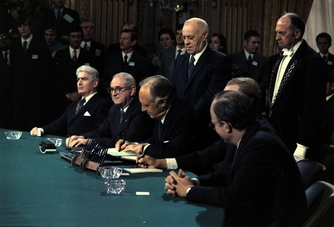Henry Kissinger Negotiations

The Signing of the Paris Peace Agreements
In October 1970 the idea of having a Peace Agreement was established in Paris, France. National Security Advisor Henry Kissinger had been secretly meeting with the North Vietnamese Communist negotiator, Le Duc Tho, outside of Paris to discuss the outcomes of the potential end of war. They knew that if an agreement were made, it would mean withdrawal of American troops, removing the military giant. It entailed sending all the American troops home and freeing all of the Prisoners of War. It even would result in more political stability for South Vietnam. When America agreed to give Vietnam economic assistance to repair their destroyed infrastructure, Nixon declared that Peace was “at hand”, or very close. However the South Vietnamese Leader, Nguyen Van Thieu, became enraged that he had not been consulted and demanded various outrageous changed in order for him to agree to Peace. President Nixon then made the decision to bribe Thieu. He promised $1 million in military weaponry and aerial equipment, as well as the guarantee that America would invade North Vietnam again if they didn’t abide to the Peace Agreements. In Paris during the January of 1973, after Nixon decided to “punish” the North Vietnamese armies with bombing, talks of peace resumed. On January 27th, an official peace agreement was signed by all of the National leaders. The conditions were almost identical to those made almost a year ago between Kissinger and Tho. Kissinger had successfully established the Paris Peace Accords that ended the long Vietnam War, and negotiated his way out of a very tough situation. He later warranted these Accords through saying, “We believed that those who opposed the War in Vietnam would be satisfied with our withdrawal, and those who favored an honorable ending would be satisfied if the United States would not destroy and ally.” The following March, the U.S. withdrew their troops, and all of the soldiers were able to return home to their families.
